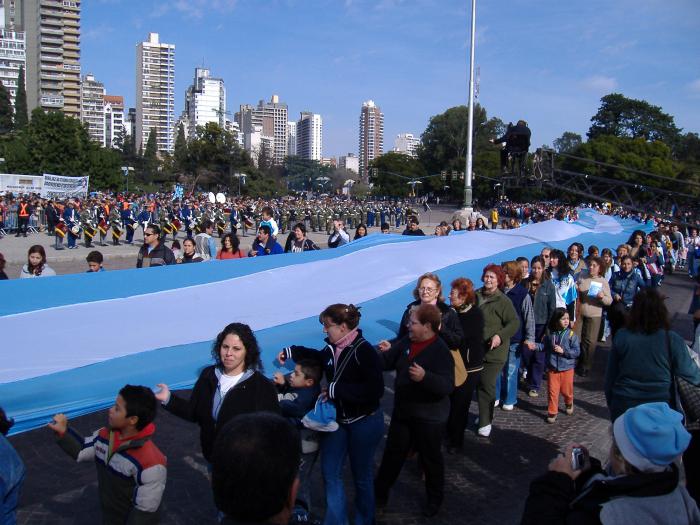Argentina is a South American state with great traditions rooted in the country's history. Coat of arms and flag of Argentina- an opportunity to reflect the diversity of Argentine culture and reveal the individual spirit of Argentine freedom.
This is a panel of classic proportions (2: 3), which became the national flag of Argentina since 1812, much earlier than it was adopted. coat of arms of Argentina... The flag was designed by Manuel Belgrano. This is a famous Argentine politician and military leader who studied in Spain and received a law degree. This did not prevent him from taking an active part in the struggle of the Argentine people for independence from spanish crown... Officially Argentina flag, proposed by Belgramo, was not accepted by the government of the country, but four years later the blue and white cloth began to be considered one of the official symbols of the new independent state within the territory of Latin America.
Scientists have just answered this question. For Argentines, this detail is fundamental. This is a story that is rewritten in one color, that is, the color of the reigning dynasty in Spain during independence, so if the Argentine fathers chose the color of the Bourbons at a crucial moment, it is that they were looking for a compromise with Spain, not a break.
Now it happens that the flag of Tucuman was offered to the city by a close friend of Belgrano, who necessarily had in his heart a respect for the true colors of the first flag that dates back. It is clear that over time and as independence claims, the blue flag disappeared and it moved away from the blue Spanish bourbon.
So the current Argentina flag is a rectangle divided horizontally into three parts. The upper and lower parts are blue. They personify the pale blue Argentine sky - and this is the official version. However, about the flag of Argentina, there are other thoughts that take place among the people. It is said that the blue color on the flag symbolizes the La Plata River, the country's main river. The white color of the middle band officially means clouds, and unofficially it is the color of silver. Indeed, the very name of the country Argentina owes its appearance to the word "silver". There is also completely alternative version, whose supporters claim that the blue and white colors are the color of the Virgin Mary's clothing. There are those who see the colors of the Argentine national flag in the colors of the Bourbon dynasty, but the supporters of this idea are in the minority. In the middle white stripe there is an image of the sun. In this case, everyone agrees that the sun is not just a symbol of the new Argentina, but also an image of the ancient deity of the Inca empire. Officially, the sun on the Argentine flag is named May in honor of the Argentine revolution.
Press review in Turkey with referendum won by Recep Tayyip Erdogan. ... "Despite the hopes of a strong majority - more than 55%, the constitutional reform won only a small majority, leaving behind its socio-politically divided country."
If Erdogan does not understand that an almighty president is not capable of such a strong opposition. This is not the opinion of another pro-government newspaper: Sabah, which recalls that the Turkish parliamentary system was forged by successive coups, the leaders of which were priority over control rather than governance and its shortcomings can no longer match Turkey today.
In fact, Argentina has two flags. The first, by the way, did not have an image of the sun. It is still the festive flag of the state. And the one, in the middle of which the May sun flaunts, bears the status of an official ceremonial. According to Argentine law, the official ceremonial flag must be flown higher than the festive flag. June 20th Argentineans celebrate National Flag Day.
For the daily "It is time for Turkey to adopt a system of government that reflects the boundless dynamism and youth of its population, a presidential system." The Turkish electorate said yes to a more efficient system of government, faster economic growth and political stability, and reaffirmed Turkey's political maturity.
Finally, the news of Salt Bae. In the center of the white stripe is the sun with rays; the sun is equipped with a human face representing the Inca sun god called Inti. His inspiration sparked admiration for the sun on the Paraná coast from Rosario. It should be noted that most of the flags of Latin American countries have inspired the Argentine flag.

It is a rather unusual system of images for heraldry. In the center of the Argentine coat of arms is an oval area divided into two equal parts: white and blue. Against her background - two hands joined by a handshake. Behind the image of the hands is the so-called red Phrygian (Thracian) cap, which personifies freedom and revolution. The cap became such a symbol after the French Revolution, and then its image migrated to the Argentine coat of arms. Around the oval field coat of arms of Argentina depicts laurel branches tied at the bottom with a ribbon in the colors of the national flag, and the top of the coat of arms flaunts rising Sun... The image of the sun here is in harmony not only with the official flag of Argentina, but also with the country's anthem.
Before the war, the flag was completely devoid of sunlight in its environment. In those days, one could notice only the presence of three groups, how they are arranged on that day. Regarding the theory of flowers, it was said that the Argentines were opposed to the invasion launched by Napoleon, the new "supreme" commander of France. Solidarity to support Spain, it was decided that the colors of the Bourbons will be used in blue and white; colors of the king of Spain.
The sun is gold and will have 16 wave beams and 16 straight beams. The meaning of the flag elements. It is a powerful message that wants to be attached in everyone's mind. This is reminiscent of the first day of the May uprising. Argentina's temperatures are often generous to give sunshine for the length of the year; on the contrary, it often snows in the country, which returns the symbol to its first meaning in connection with the revolution.
It is believed that the official acceptance coat of arms of Argentina happened only in 1944, although heraldic images were used on the seals of 1813.
Reflection flag and coat of arms of Argentina manifests itself in different spheres of life of Argentines. This is how the national football team of this country is called "alba-celeste" - "blue and white".
The clear and bright skies of Pampa or Patagonia leave their mark on the blue color of the flag's two stripes. When approaching it, you can more accurately distinguish that the rays of the sun are straight and wavy. Half of the rays are straight and the other half are wavy. The rights vaguely resemble the classical representation of the Sun, and the waves are typical rays of the Inca representation.
Ideas abound, however, and colors place a lot of importance. Thus, White means the representation of a monarchy of divine origin; blue creature - freedom of thought and expression. This blue merged with white, and then gave a blue sky in the form of a parliamentary monarchy. A very religious country, the blue sky also stretches from the color of the mantle of the Most Holy Theotokos.
Also see:
Argentina is one of the most amazing countries South America... The culture of Argentina is distinguished by its special originality, since many ethnic groups, confessions, traditions and views are intertwined in this state. This state is home to great poets, artists and scientists.
If we talk about the most developed states of South America, then Argentina, of course, can be ranked among such countries. The population of Argentina is growing from year to year, as is the standard of living of an ordinary Argentine. Let's analyze the situation with the current demographic situation of this Latin American state.
Every June 20, Argentines celebrate the flag. This day is a holiday and is fully provided to the flag. It is also the commemoration day of its creator, Manuel Belgrano. The Argentine people attach great importance to the value of the flag; therefore it is time for the festive and ceremonial. Although declared the day of the flag, the Argentines respect its creator, who is none other than General Manuel Belgramano. To celebrate the flag with dignity every June 20th, the buildings are in honor of the flag. During this festival, colors are embedded in values; blue and white Argentina with gold is in the midst of cultural value.
Argentina is a state that is located on the South American continent and boasts rich history and original traditions. National symbols are held in high esteem in this country. Argentina considers its flag and coat of arms to be something more than state symbols. Through them, she demonstrates to the whole world the diversity of her culture and reveals a unique spirit of freedom. Even the national football team of this country is called "Alba Celeste", which is translated as "blue and white".
A flag monument was built in the city of Rosario. Construction is located in national park, in the same place where the first flag was raised. Between celebrations and divine and suggestive, Argentines see this flag as a strong symbol of shared thinking. Under divine protection and with colors reflecting unparalleled wealth, the Argentine flag is the state of the present state, nation and population.
The Brazilian flag is made up of three highlighted colors: green, yellow, and blue. The flag is both the national flag and the flag of the Federative Republic of Brazil. The flag is a rectangle for the dominance of green; in the center of the rectangle is a yellow diamond containing a dark blue disc.
general description
The national flag has the shape of a rectangle, the length and width of which are matched like two to one. The cloth consists of three strips of equal height, arranged horizontally. The two outermost ones are made in light blue. As for the middle line, it is white. In the center of the flag of Argentina (photos below), a yellow image of the May sun is applied. It is considered one of the national symbols of the country and marks the revolutionary events of May.
Twenty-six white stars are distributed at the bottom of the stripe disk, and only one star is at the top. The stars do not assume a well-defined geometric shape, but give the impression of a random distribution. The colors symbolize the country's rich wealth: green for the dense Amazonian forest and yellow for gold, which is abundant in Brazil. The blue globe symbolizes the southern hemisphere.
Yellow and green also have a different meaning. Yellow, for its part, was the symbol of the Hasburgs; it was the Swiss dynasty that ruled Brazil for a while. The stars, with seemingly random positions, represent constellations. Thus, the latter are exact replicas of the real aspect of the celestial storehouse.
History of appearance
The state flag of this South American country was first officially recognized in 1812. It should be noted that this version was different from modern version lack of a pattern on the white stripe. It should be noted that one and the other flag of Argentina as of today is a valid symbol. The version with the sun is known as a ceremonial official symbol, and without it it has the status of a festive canvas. The fundamental difference in their use is that in the first case the flag is always raised higher.
At that time, during colonial empire, Brazil didn't have a flag yet. Of course, there were flags, but the latter were representatives of the monarch's representatives. The official flag attributed to the nation did not yet exist. However, the flag of the Princes of Brazil is the first image of Brazil on the flag. In those days, a white background and an armored sphere prevailed, which later became the symbol of the symbol of Brazil. Years later, the flag changes quite consistently, while maintaining the most significant values for the country.
The imperial flag appeared in front of the real national flag. It was conceived on the occasion of the first official existence of Brazil as a state. The official flag we know in our speech today is dated November 19th. The yellow and green colors of the imperial flag have not been erased; central part was changed. This latest project is Teixeira Mendes, Miguel Lemos and Decio Vilares.
Interesting historical fact is that the right to use the version with the image of the sun for a long time had only government, provincial and national organizations. As for individuals, they were allowed to use only the flag without its image. This provision was even approved at the government level by a special legislative act, which was canceled in 1985.
After the adoption of the Imperial Flag, Brazil also had two more flags. Encouraged by the United States, the flag tried to erase the imperial footprints and showed other signs. This was dismissed very quickly as it did not represent Brazilian value in all its condition.
The unique colored flag has a very specific cultural movement. While most flags use red for their strong and explicit symbol, Brazil wants to be unique. On the road to tropization in the country, yellows and greens reflect the constant dynamism of the people. In addition, Brazilian people have easily adapted to the colors, whether through dressing or during carnivals.

Symbolism
According to the most common version, the flag of Argentina symbolizes the white color of the snowy Andes and the blue sky of the country. At the same time, some historians argue that this particular color combination was used by the Bourbon dynasty. There is also a third version. It boils down to the fact that the colors of the Argentine national symbol are associated with the clothes of the Virgin Mary. It is impossible not to note the unofficial interpretation of the symbols. In particular, the blue color in Argentina often means its main river - La Plata, and the white color means silver, after which the entire state is named. At the same time, the sun historically symbolizes the god of the Inca state.
The flag as perceived by people. Most of the Brazilian people appropriated the flag, while others, on the other hand, provided it to the state that is the rightful owner. In general truth, a flag is the flag of a country, which means that it belongs to both the population and the state. Brazil is a country with a wide variety of cultural identities. The flag itself is “everything” that encompasses the cultures transferred. A symbol of unification and strength, the flag is at the same time a country, citizens and a state. It helps to give personality to a country that sets it apart from other countries.
June 20
The Argentine flag is so respected in the state that there is even a national holiday in the country that is dedicated to it. It is celebrated on June 20. The fact is that it was on this day in 1820 that its author, Manuel Belgran, died. Moreover, in the hometown of this person (Rosario), it is celebrated for a whole week. It should be noted that here the flag of Argentina even has its own monument, which the national symbols of many other countries cannot boast of. 
The Argentine flag is one of those pretty light: three horizontal stripes; white - in the middle, inside Sol de Mayo - and two blue ones, above and below. The problem, as the economist wrote, is that no one knows exactly how it should be heavenly. In fact, maybe it should be blue and rather dark. The flag had clearly disappeared, but the scientists did chemical analysis, used X-rays and did spectroscopy, finding that blue flags were used with azure, which, by the way, produce a dark blue color.
To summarize, on the one hand, there were the federal ones, led by Juan Manuel de Rosas, wanted a decent government and used flags and flags with very blue. Manuel Belgrano in the painting by Rafael del Villard. Two horizontal stripes in blue and gold sunlight on a white background. The Argentine national flag is well known all over the world, known, for example, for the great football team in Maradona or Messi.
National coat of arms
The colors of the flag are used as the background for the national coat of arms. It depicts a shaking hands near which is considered a symbol of prosperity, equality and freedom. The top of the cap hangs to one side, and it itself is rounded. The same symbol was used by some tribes who have long inhabited the area. In addition, the symbol of the nation - the rising sun - is placed on the coat of arms, and it itself is decorated with oak branches.
However, today, in the midst of his death, which falls in June, schoolchildren add to the "white and blue" colors. That could be the case, according to a study published on the last day of the chemistry journal. Argentine and Brazilian researchers examined the silk thread of the oldest Argentine flag and made a surprising conclusion: the shadow was quite ultramarine, much darker than it is currently blurred. This is much more than the correct flag color.
The federalist leadership of autocratic Juan Manuel de Roses fought for the decentralization of countries with strong autonomy of individual provinces under the blue flag. The Centralist, who wanted strong power for the government in Buenos Aires, merged under a lighter shade.




